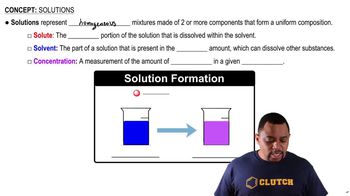You make a solution of a nonvolatile solute with a liquid solvent. Indicate if each of the following statements is true or false. (b) The solid that forms as the solution freezes is nearly pure solute.
Ch.13 - Properties of Solutions

Brown14th EditionChemistry: The Central ScienceISBN: 9780134414232Not the one you use?Change textbook
Chapter 13, Problem 64
The vapor pressure of pure water at 60 °C is 149 torr. The vapor pressure of water over a solution at 60 °C containing equal numbers of moles of water and ethylene glycol (a nonvolatile solute) is 67 torr. Is the solution ideal according to Raoult's law?
 Verified step by step guidance
Verified step by step guidance1
Identify the components of the solution: water (solvent) and ethylene glycol (nonvolatile solute).
Recall Raoult's Law: The vapor pressure of a solvent over a solution (P_solution) is equal to the mole fraction of the solvent (X_solvent) times the vapor pressure of the pure solvent (P_pure).
Calculate the mole fraction of water in the solution. Since there are equal moles of water and ethylene glycol, the mole fraction of water (X_water) is 0.5.
Apply Raoult's Law: P_solution = X_water * P_pure. Substitute the known values: P_solution = 0.5 * 149 torr.
Compare the calculated vapor pressure from Raoult's Law with the given vapor pressure of the solution (67 torr) to determine if the solution behaves ideally.

Verified video answer for a similar problem:
This video solution was recommended by our tutors as helpful for the problem above.
Video duration:
1mWas this helpful?
Key Concepts
Here are the essential concepts you must grasp in order to answer the question correctly.
Raoult's Law
Raoult's Law states that the vapor pressure of a solvent in a solution is directly proportional to the mole fraction of the solvent present. For an ideal solution, the presence of a nonvolatile solute lowers the vapor pressure of the solvent compared to its pure state. This law helps predict how solutes affect the vapor pressure of solvents, which is crucial for understanding the behavior of solutions.
Recommended video:
Guided course

Raoult's Law and Vapor Pressure
Vapor Pressure
Vapor pressure is the pressure exerted by a vapor in equilibrium with its liquid or solid phase at a given temperature. It reflects the tendency of particles to escape from the liquid phase into the vapor phase. In the context of solutions, the vapor pressure of the solvent decreases when a nonvolatile solute is added, which is a key aspect of Raoult's Law.
Recommended video:
Guided course

Raoult's Law and Vapor Pressure
Ideal Solutions vs. Non-Ideal Solutions
An ideal solution is one that follows Raoult's Law perfectly, meaning the interactions between different molecules are similar to those between like molecules. Non-ideal solutions, on the other hand, exhibit deviations from Raoult's Law due to differences in molecular interactions. The extent of these deviations can indicate whether a solution behaves ideally or not, which is essential for analyzing the given scenario.
Recommended video:
Guided course

Solution Components
Related Practice
Textbook Question
Textbook Question
You make a solution of a nonvolatile solute with a liquid solvent. Indicate if each of the following statements is true or false. (d) The boiling point of the solution increases in proportion to the concentration of the solute. (e) At any temperature, the vapor pressure of the solvent over the solution is lower than what it would be for the pure solvent.
Textbook Question
At 63.5 °C, the vapor pressure of H2O is 175 torr, and that of ethanol (C2H5OH) is 400 torr. A solution is made by mixing equal masses of H2O and C2H5OH. (a) What is the mole fraction of ethanol in the solution?
